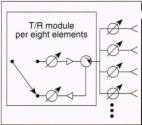This part here describes HHQ-9's guidance, and divides into Passive and Active. Passive here sounds like typical inertial guidance with datalink update or command guidance. The missile then transitions to active homing state.
In the passive or midphase command guidance state, there is an issue with the missile's tail radar cross section, which if its too low will give trouble. The radar still has to be able to track the missile and send instructions to it.
Author wasn't happy when Institute 23 did not furnish the correct data on the missile's tail radar cross section which turned out to be smaller than the head.
In September, President Hua (Haigen Hua), Wang Jun and I went to the 8th Academy of the Ministry of Aerospace (Missile General) of the Ministry of Aerospace in Shanghai to ask about missile guidance modes and other issues. President Hua has done target testing with the experts of the institute and has a good relationship with the leaders of the institute. We asked them a lot of missile issues as students. Long-range missile strikes are divided into two stages, passive guidance and active guidance. In the passive guidance section, after the missile is launched, it is tracked by radar and sends correction instructions to guide the missile to the target. The active guidance section is when the missile approaches the target and turns on the active homing function to automatically seek and hit the target. The purpose of our research is to know how long the missile can be actively guided? What is the power and sensitivity of the response antenna on the missile? And what is the orbit of the missile launch section? The signal receiving direction of the response antenna on the missile, the accuracy requirements of the passive guidance terminal missile and the target, and the actual data of the reflection cross-sectional area of the missile's head, tail, and sides in various directions, etc.
In the passive or midphase command guidance state, there is an issue with the missile's tail radar cross section, which if its too low will give trouble. The radar still has to be able to track the missile and send instructions to it.
Author wasn't happy when Institute 23 did not furnish the correct data on the missile's tail radar cross section which turned out to be smaller than the head.
In July and August of 1993, Nanjing was as hot as a stove. The 14th institute first had a half-day shift. By the end of July and early August, there were about two weeks of non-working all day. And I spent morning to night in the computer room to study, calculate and simulate the low-angle tracking performance of the S-band phased array radar, and find ways to improve its performance. At the same time, it also cooperated with Nanjing University of Aeronautics and Astronautics and asked them to help simulate the reflection cross-sectional area of the HH-9 missile at various angles. We can't believe that the 23rd Institute of the Ministry of Space and Space has spoken out!
There is air conditioning in the computer room, and the high temperature outside the computer room exceeds 36 degrees. People are very susceptible to colds as soon as they enter and exit. I was taking cold medicine, and I insisted on fighting in the computer room alone. At home, my daughter was lying on the bed due to a fractured bone and was taken care of by my in-laws. (I feel guilty about my daughter so far. She has graduated from Harvard Ph.D. I see the scar on her foot, I will feel heartache). Hard work pays off. In two months, I found some ways to improve the radar's low-angle tracking performance by using the characteristics of active arrays (the article was later published in "Modern Radar"); at the same time, I went to Nanjing University of Science and Technology to find a radar theory expert ( Such as Professor Liu Guosui) and PhD students discussed the solution together, and they later published several papers in this area. At the same time, the experts of China Southern Airlines also helped us to simulate the reflection cross-sectional area of the HH-9 missile at various angles. It can be seen that the reflection cross-sectional area data given by 23 of the Second Academy of the Ministry of Aerospace Industry is problematic. The most obvious problem is that they said that the reflection cross-sectional area of the missile tail is smaller than the reflection cross-sectional area of the missile head.
In September, President Hua (Haigen Hua), Wang Jun and I went to the 8th Academy of the Ministry of Aerospace (Missile General) of the Ministry of Aerospace in Shanghai to ask about missile guidance modes and other issues. President Hua has done target testing with the experts of the institute and has a good relationship with the leaders of the institute. We asked them a lot of missile issues as students. Long-range missile strikes are divided into two stages, passive guidance and active guidance. In the passive guidance section, after the missile is launched, it is tracked by radar and sends correction instructions to guide the missile to the target. The active guidance section is when the missile approaches the target and turns on the active homing function to automatically seek and hit the target. The purpose of our research is to know how long the missile can be actively guided? What is the power and sensitivity of the response antenna on the missile? And what is the orbit of the missile launch section? The signal receiving direction of the response antenna on the missile, the accuracy requirements of the passive guidance terminal missile and the target, and the actual data of the reflection cross-sectional area of the missile's head, tail, and sides in various directions, etc.
Last edited:

